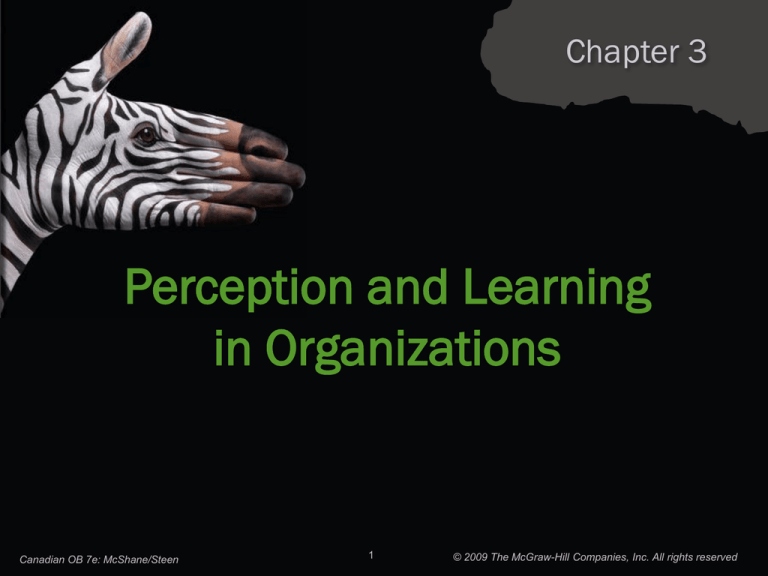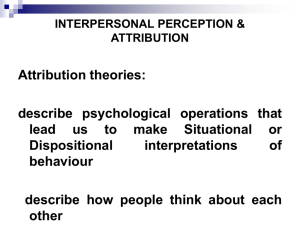
Chapter 3
Perception and Learning
in Organizations
Canadian OB 7e: McShane/Steen
1
© 2009 The McGraw-Hill Companies, Inc. All rights reserved
Moya Greene, Canada Post
Canada Post CEO Moya
Greene keeps her perception in
focus by communicating with
employees and encouraging
them to share their perceptions
about their jobs and the
corporation. She has also
performed several jobs, from
sorting mail to delivering it.
Moya Greene
Canada Post CEO
Perception Defined
The process of receiving
information about and making
sense of the world around us
• deciding which information to
notice
• how to categorize this
information
• how to interpret information
within our existing knowledge
framework
Selective Attention
Characteristics of the object
• size, intensity, motion,
repetition, novelty
Characteristics of the
perceiver
• Emotional marker process
• Expectations
• Self-concept and beliefs
Confirmation bias
• Screen out information
contrary to our beliefs/values
Perceptual Organization/Interpretation
Categorical thinking
• Mostly nonconscious process of organizing
people/things
Perceptual grouping principles
• Similarity or proximity
• Closure -- filling in missing pieces
• Perceiving trends
Interpreting incoming information
• Emotional markers automatically evaluate
information
Mental Models in Perceptions
Broad world-views or ‘theories-in-use’
Help us to quickly make sense of situations
• Fill in missing pieces
• Help to predict events
Problem with mental models:
• May block recognition of new
opportunities/perspectives
“Your Names Says It all in France”
Hamid Senni (in photo)
wears a shirt and tie
whenever he strolls along
the Champs Elysées in
Paris. The reason for this
formality? “If I'm in jeans,
people think I'm a
shoplifter,” says Senni, who
was born and raised in
France.
Hamid Senni
Social Perception and Social
Identity
Categorization process
• compare characteristics of
our groups with other groups
Homogenization process
• similar traits within a group;
different traits across groups
Differentiation process
• develop less favourable
images of people in groups
other than our own
Hamid Senni
Stereotyping
Assigning traits to people based on their
membership in a social category
Occurs because:
• Categorical thinking
• Innate drive to understand and anticipate others’
behaviour
• Enhances our self-concept
Problems with Stereotyping
Overgeneralizes
• Stereotypes don’t represent all or most people in
the category
Discrimination
• Systemic (unintentional)
• Prejudice (intentional)
Overcoming stereotype biases
• Difficult to prevent stereotype activation
• Possible to minimize stereotype application
Attribution Process
Internal Attribution
• Perception that person’s behaviour is due to
motivation/ability rather than situation or fate
External Attribution
• Perception that behaviour is due to situation or
fate rather than the person
Rules of Attribution
Internal Attribution
Frequently
Frequently
Seldom
Consistency
Distinctiveness
Consensus
Seldom
Seldom
Frequently
External Attribution
Attribution Errors
Fundamental Attribution Error
• attributing own actions to external factors and
other’s actions to internal factors
Self-Serving Bias
• attributing our successes to internal factors and
our failures to external factors
Self-Fulfilling Prophecy Cycle
Supervisor
forms
expectations
Employee’s
behaviour matches
expectations
Expectations
affect supervisor’s
behaviour
Supervisor’s
behaviour affects
employee
Self-Fulfilling Prophecy
Contingencies
Self-fulfilling prophecy effect is strongest:
1. When relationships form
2. When several people have similar expectations
about the person
3. When the employee has low past achievement
Leaders should strive to develop and maintain
positive, yet realistic, expectations of
employees
Other Perceptual Errors
Halo effect
• one trait forms a general impression
Primacy effect
• first impressions
Recency effect
• most recent information dominates perceptions
False-consensus effect
• overestimate the extent to which others have
beliefs and characteristics similar to our own
Strategies to Improve Perceptions
Awareness of perceptual biases
2. Improving self-awareness
1.
• Applying Johari Window
3.
Meaningful interaction
• Close and frequent interaction toward a shared
goal
• Equal status
• Engaged in a meaningful task
Know Yourself (Johari Window)
Feedback
Known to Self
Known
to Others
Disclosure
Open
Area Open
Area
Hidden
Area
Hidden
Unknown
to Others
Area
Unknown to Self
Blind
Area Blind
Area
Unknown
Unknown
Area
Area
Definition of Learning
A relatively permanent change in
behaviour (or behaviour tendency) that
occurs as a result of a person’s
interaction with the environment
Explicit vs.Tacit Knowledge
Explicit knowledge
• Knowledge that is articulated through language,
such as documents
Tacit knowledge
• Knowledge acquired through observation and
direct experience
Behavior Modification
We “operate” on the environment
• alter behaviour to maximize positive and minimize
adverse consequences
Learning is viewed as completely dependent
on the environment
Human thoughts are viewed as unimportant
A-B-Cs of Behavior Modification
Antecedents
Behaviour
Consequences
What happens
before behaviour
What person
says or does
What happens
after behaviour
Machine
operator turns
off power
Co-workers
thank
operator
Example
Warning
light
flashes
Contingencies of Reinforcement
Consequence
is introduced
Behavior
increases/
maintained
Positive
reinforcement
Behavior
decreases
Punishment
No
consequence
Consequence
is removed
Negative
reinforcement
Extinction
Punishment
Reinforcing the Healthy Walk
Horton’s Group, the Chicagobased insurance broker rewards
staff who take at least 7,000 steps
each day. Health insurance giant
Humana introduced a similar
program where data from
pedometers are uploaded to a
website. The more steps one
takes the higher the reward.
Behavior Modification in Practice
Behavior modification is used in:
• every day life to influence behaviour of others
• company programs to reduce absenteeism,
improve safety, etc.
Behavior modification problems include:
• Reward inflation
• Behaviorist philosophy vs. learning through mental
processes
Social Learning Theory
Behavioral modelling
• Observing and modelling behaviour of others
Learning behaviour consequences
• Observing consequences that others experience
Self-reinforcement
• Reinforcing our own behaviour with consequences
within our control
Learning Through Experience
Most tacit knowledge and skills are acquired
through experience and observation
Experiential learning steps
• Engagement with environment
• Reflecting on experience
• Experimenting
Developing a Learning Orientation
Value the generation of new knowledge
Reward experimentation
Recognize mistakes as part of learning
Encourage employees to take reasonable
risks
Organizational Learning
Knowledge acquisition
• Extracting information and ideas from the external
environment as well as through insight
Knowledge sharing
• Distributing knowledge to others across the
organization
Knowledge use
• Applying knowledge in ways that adds value to the
organization and its stakeholders
Chapter 3
Perception and Learning
in Organizations
Canadian OB 7e: McShane/Steen
30
© 2009 The McGraw-Hill Companies, Inc. All rights reserved






